
(a)
Interpretation:
The enol structure of the compound 2-methylcyclohexanone is to be drawn. The explanation as to why the compound does not form enol structure is to be stated.
Concept introduction:
Answer to Problem 22.7P
The enol structures of the compound 2-methylcyclohexanone are shown below.
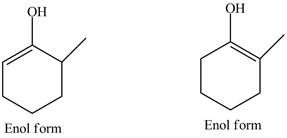
Explanation of Solution
The structure of 2-methylcyclohexanone is shown below.

Figure 1
In the compound, 2-methylcyclohexanone, there are α-hydrogens present on both sides of the carbonyl group. The compound 2-methylcyclohexanone can undergo keto-enoltautomerism by the transfer of α− hydrogen. Therefore, the keto-enoltautomerism in 2-methylcyclohexanone is shown below.

Figure 2
The compound 2-methylcyclohexanone has two enol forms.
The enol structures of the compound 2-methylcyclohexanone are shown in Figure 2.
(b)
Interpretation:
The enol structure of the compound 2-methylpentanoic acid is to be drawn. The explanation as to why the compound does not form enol structure.
Concept introduction:
Ketone also exists in two forms which are commonly known as keto-enol tautomerism. Tautomers are isomers which differ only in the position of the protons and electrons of the double bond of the electronegative atom in the compound. There is no change in the carbon skeleton of the compound. This phenomenon which involves simple proton transfer in an intramolecular fashion is known as tautomerism.
Answer to Problem 22.7P
The enol structure of the compound 2-methylpentanoic acid is shown below.
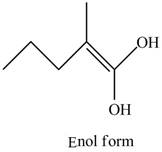
Explanation of Solution
The structure of given compound 2-methylpentanoic acid is shown below.
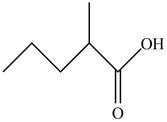
Figure 3
In the compound, 2-methylpentanoic acid, there is α− hydrogen present on one side of the carbonyl group. The compound 2-methylpentanoic acid can undergo keto-enoltautomerism by the transfer of α− hydrogen. Therefore, the keto-enoltautomerism of 2-methylpentanoic acid is shown below.

Figure 4
The enol structure of the compound 2-methylpentanoic acid is shown in Figure 4.
(c)
Interpretation:
The enol structure of the compound benzaldehyde is to be drawn. The explanation as to why the compound does not form enol structure.
Concept introduction:
The carbonyl compound contains a >C=O group. They are of two types
Answer to Problem 22.7P
There is no α− hydrogen in benzaldehyde. Therefore, it does not have any enol structure.
Explanation of Solution
The given compound benzaldehydeis shown below.

Figure 5
In the compoundbenzaldehydethere is no α− hydrogens present on either side of the carbonyl group. It is not possible that benzaldehyde will undergo keto-enoltautomerism. Therefore, no enol forms will be observed.
In benzaldehyde, due to the absence of α− hydrogen no enol structures will be obtained.
(d)
Interpretation:
The enol structure of the compound N,N-dimethylacetamide is to be drawn. The explanation as to why the compound does not form enol structure.
Concept introduction:
Ketone also exists in two forms which are commonly known as keto-enol tautomerism. Tautomers are isomers which differ only in the position of the protons and electrons of the double bond of the electronegative atom in the compound. There is no change in the carbon skeleton of the compound. This phenomenon which involves simple proton transfer in an intramolecular fashion is known as tautomerism.
Answer to Problem 22.7P
The enol structure of the compound N,N-dimethylacetamide is shown below.
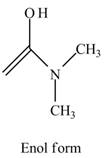
Explanation of Solution
The structure of the given compound N,N-dimethylacetamide is shown below.
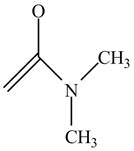
Figure 6
In the compound, N,N-dimethylacetamide there are α− hydrogens present on one side of the carbonyl group. The compound N,N-dimethylacetamide can undergo keto-enoltautomerism by the transfer of α− hydrogen. Therefore, the keto-enoltautomerism in N,N-dimethylacetamide is shown below.
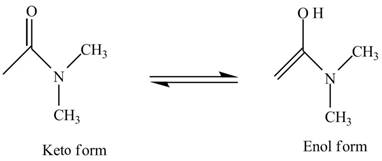
Figure 7
The enol structure of the compound N,N-dimethylacetamide is shown in Figure 7.
(e)
Interpretation:
The enol structure of the compound N,N-dimethylformamide is to be drawn. The explanation as to why the compound does not form enol structure.
Concept introduction:
Ketone also exists in two forms which are commonly known as keto-enol tautomerism. Tautomers are isomers which differ only in the position of the protons and electrons of the double bond of the electronegative atom in the compound. There is no change in the carbon skeleton of the compound. This phenomenon which involves simple proton transfer in an intramolecular fashion is known as tautomerism.
Answer to Problem 22.7P
There is no α- hydrogen in N,N-dimethylformamide. Therefore, it does not have any enol structure.
Explanation of Solution
The given compound N,N-dimethylformamide is shown below.
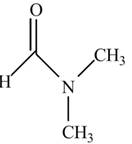
Figure 8
In the compound N,N-dimethylformamide, there are no α- hydrogens present on either side of the carbonyl group. It is not possible that N,N-dimethylformamide will undergo keto-enoltautomerism. Therefore, no enol forms will be observed.
In N,N-dimethylformamide, due to the absence of α- hydrogen, no enol structures will be obtained.
Want to see more full solutions like this?
Chapter 22 Solutions
ORGANIC CHEM +SG +SAPLING >IP<
- 1. Part 1: Naming Organic Compounds он H₁C-C-CH3 CH3 Br CI CI 2. Br-CH-CH-CH₂ H₂C-CH-C= -CH-CH2-CH3 3. HC-CH-CH-C-OH 5. H₂C-CH-CH₂-OH 7. OH 4. CH CH₂-CH₂ 6. сно CH-CH-CH-CH₂-CH₂ H₁₂C-CH-CH-CH-CH₁₂-CH₁₂ 8. OHarrow_forward11 Organic Chemistry Organic Nomenclature Practice Name/Functional Group n-butane Formula Structural Formula (1) C4tt10 H3C C- (2) CH3CH2CH2 CH 3 H₂ -CH3 Н2 name & functional group (1) and (2) OH H₁₂C Н2 name only (1) and (2) name only (1) and (2) H₁C - = - CH₂ Н2 HC=C-C CH3arrow_forwardUnder aqueous basic conditions, nitriles will react to form a neutral organic intermediate 1 that has an N atom in it first, and then they will continue to react to form the final product 2: NC H₂O он- H₂O 1 2 OH Draw the missing intermediate 1 and the final product 2 in the box below. You can draw the two structures in any arrangement you like. Click and drag to start drawing a structure.arrow_forward
- Assign these COSY Spectrumarrow_forwardAssign these C-NMR and H-NMR Spectrumarrow_forwardPredict the product of this organic reaction: IZ + HO i P+H₂O Specifically, in the drawing area below draw the skeletal ("line") structure of P. If there is no reasonable possibility for P, check the No answer box under the drawing area. No Answer Click and drag to start drawing a structure. ☐ :arrow_forward
- Predict the products of this organic reaction: 0 O ----- A + KOH ? CH3-CH2-C-O-CH2-C-CH3 Specifically, in the drawing area below draw the condensed structure of the product, or products, of this reaction. (If there's more than one product, draw them in any arrangement you like, so long as they aren't touching.) If there aren't any products because this reaction won't happen, check the No reaction box under the drawing area. No reaction Click anywhere to draw the first atom of your structure. X ⑤ èarrow_forwardPredict the products of this organic reaction: O CH3 + H2O + HCI A A? CH3-CH2-C-N-CH3 Specifically, in the drawing area below draw the condensed structure of the product, or products, of this reaction. If there's more than one product, draw them in any arrangement you like, so long as they aren't touching. If there aren't any products because this reaction won't happen, check the No reaction box under the drawing area. No Reaction Click anywhere to draw the first atom of your structure.arrow_forwardWhat is the missing reactant in this organic reaction? R+ HO-C-CH2-CH3 0= CH3 CH3 —CH, C−NH—CH CH3 + H₂O Specifically, in the drawing area below draw the condensed structure of R. If there is more than one reasonable answer, you can draw any one of them. If there is no reasonable answer, check the No answer box under the drawing area. Note for advanced students: you may assume no products other than those shown above are formed. No Answer Click anywhere to draw the first atom of your structure. €arrow_forward
- 个 CHEM&131 9267 - $25 - Intro to Mail - Hutchison, Allison (Student x Aktiv Learnin https://app.aktiv.com Draw the product of the reaction shown below. Ignore inorganic byproducts. + Na2Cr2O7 Acetone, H2SO4 Type here to search Dryng OH W Prarrow_forwardPredict the products of this organic reaction: OH + NaOH A? Specifically, in the drawing area below draw the skeletal ("line") structure of the product, or products, of this reaction. (If there's more than one product, draw them in any arrangement you like, so long as they aren't touching.) If there aren't any products because this reaction won't happen, check the No reaction box under the drawing area. No reaction Click and drag to start drawing a structure. ✓ Sarrow_forwardPredict the products of this organic reaction: CH3-C-O-CH2-CH2-C-CH3 + H₂O ? A Specifically, in the drawing area below draw the condensed structure of the product, or products, of this reaction. (If there's more than one product, draw them in any arrangement you like, so long as they aren't touching.) If there aren't any products because this reaction won't happen, check the No reaction box under the drawing area. No reaction Click anywhere to draw the first atom of your structure. :☐ darrow_forward
 ChemistryChemistryISBN:9781305957404Author:Steven S. Zumdahl, Susan A. Zumdahl, Donald J. DeCostePublisher:Cengage Learning
ChemistryChemistryISBN:9781305957404Author:Steven S. Zumdahl, Susan A. Zumdahl, Donald J. DeCostePublisher:Cengage Learning ChemistryChemistryISBN:9781259911156Author:Raymond Chang Dr., Jason Overby ProfessorPublisher:McGraw-Hill Education
ChemistryChemistryISBN:9781259911156Author:Raymond Chang Dr., Jason Overby ProfessorPublisher:McGraw-Hill Education Principles of Instrumental AnalysisChemistryISBN:9781305577213Author:Douglas A. Skoog, F. James Holler, Stanley R. CrouchPublisher:Cengage Learning
Principles of Instrumental AnalysisChemistryISBN:9781305577213Author:Douglas A. Skoog, F. James Holler, Stanley R. CrouchPublisher:Cengage Learning Organic ChemistryChemistryISBN:9780078021558Author:Janice Gorzynski Smith Dr.Publisher:McGraw-Hill Education
Organic ChemistryChemistryISBN:9780078021558Author:Janice Gorzynski Smith Dr.Publisher:McGraw-Hill Education Chemistry: Principles and ReactionsChemistryISBN:9781305079373Author:William L. Masterton, Cecile N. HurleyPublisher:Cengage Learning
Chemistry: Principles and ReactionsChemistryISBN:9781305079373Author:William L. Masterton, Cecile N. HurleyPublisher:Cengage Learning Elementary Principles of Chemical Processes, Bind...ChemistryISBN:9781118431221Author:Richard M. Felder, Ronald W. Rousseau, Lisa G. BullardPublisher:WILEY
Elementary Principles of Chemical Processes, Bind...ChemistryISBN:9781118431221Author:Richard M. Felder, Ronald W. Rousseau, Lisa G. BullardPublisher:WILEY





